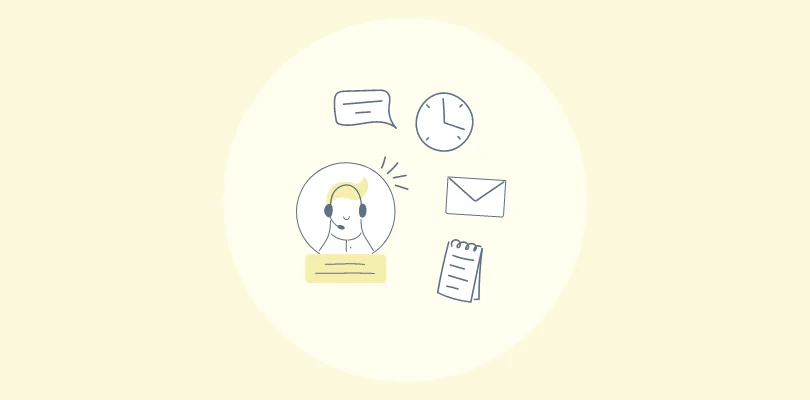When the product team has built the best product, and the sales team has surpassed its targets, it is the customer success team that ensures customers stay loyal and continue buying.
Remember how you got a call from a customer success agent who introduced you to the product, answered all your questions, and encouraged you to continue with your monthly subscriptions?
If you feel a majority of customers leave you after some time, you need to build the right customer success team. One that knows how to ensure a smooth onboarding process, personalize interactions and persuade customers to buy more.
If you wish to learn how to build a customer success team, this blog is for you.
In this blog, we will understand the definition of customer success and see how it is different from customer support. Later, we will explore some top customer success team roles and 10 actionable tips to help you build a high-performance team.
Here we go!
What Is Customer Success?
Customer success is the process of proactively helping customers reach their desired outcomes while using your products or services. The customer success department anticipates customer problems and challenges in advance and offers them the appropriate solutions to enhance the customer experience.
A well-defined customer success strategy can help your business increase customer satisfaction and retention. In addition, employees can be trained to upsell and cross-sell to customers to boost revenue. Some popular customer success metrics include customer health score, customer lifetime value, churn rate, renewal rate, etc.
What Is a Customer Success Team Responsible For?
If you are wondering what does customer success team do, this section will explain everything.
1. Onboarding New Customers
Customer onboarding is one of the central responsibilities of CS employees. They are responsible for educating customers about how a product functions, its various features, and how they can make the most out of it. The main goal is to get customers up to speed as quickly as possible to help them achieve their goals.
2. Encourage Upsells and Cross-Sells
Customer success team members are consistently interacting with customers to build better relationships. This gives them the opportunity to upsell higher-priced products and cross-sell complimentary products to customers. When done right, these sales strategies can help your business increase the average order value and boost revenue.
3. Improve Relationship Between Customers & the Support Team
While customer success teams can help with routine product or service-related queries, they are not the best choice when it comes to detailed support. For example, whenever a CS professional receives an issue that demands technical assistance, they can redirect the customer to the support team.
4. Increase Renewals
Subscription and service-based businesses are heavily dependent on renewals. One of the customer success responsibilities is to follow up with customers for renewals. This is a great strategy that can help your business retain your hard-earned customers and drive loyalty. After all, increasing customer retention by 5% increases profits by 25-95%.
Read More: How to Build a Customer Retention Strategy
3 Pillars of a High-Performing Customer Success Team
We all know that strong pillars lead to the strong foundation of a building. The same applies to your team.
The three pillars, Impact, Engagement, and Experience, set the foundation to a high-performing customer success team.
1. Impact
“Success is not delivering a feature; it is learning how to solve the customer’s problem.” – Eric Ries
The first pillar of customer success is ‘impact.’ No matter what you sell, toothbrush or SaaS products, your product or service has some impact or influence on customers. Customer success teams should be able to convey how their brand offerings can positively impact the lives of their customers.
2. Engagement
“Get closer than ever to your customers. So close that you tell them what they need well before they realize it themselves.” – Steve Jobs
The second pillar is ‘Engagement.’ Modern customers respect businesses that do not forget about them once they have made a purchase. Successful customer success teams should strive to engage and educate customers through multiple channels. Consistent engagement will keep your business at the top of the customer’s mind when they are ready to make a purchase.
3. Experience
“The customer experience is the next competitive battleground.” – Jerry Gregoire
The third pillar is ‘Customer Experience,’ which consists of multiple touchpoints – from the onboarding process to after-sales support. Every opportunity you get to interact with a customer, you can make it a delightful experience that they can never forget. According to research, businesses with a customer experience (CX) mindset drive revenue up to 4-8% higher than their competitors.
When to Start Building a Customer Success Team
Unlike other departments such as sales, accounts, or marketing, customer success is usually introduced at later stages of business operations. So if you think you need to build a strong team, you might as well read this section.
The best time to start is when your consumer base is growing on a month-on-month basis. A great CS team will help you retain first-time customers and increase your repeat purchase rate. Encourage your team to focus more on higher-value clients who make up the majority of your revenue.
For a start, you can hire a customer success leader with relevant team building and managing experience. The appointed individual can lay out key processes, implement new strategies, and help your team hire the right people. Based on your current and anticipated needs, you can hire more people accordingly.
FREE. All Features. FOREVER!
Try our Forever FREE account with all premium features!
10 Steps to Building a Strong Customer Success Team
Managing a customer success team can become effortless once you have built the right team. Just like a great dish has all the right ingredients, your team should be composed of the right people with the right skill sets.
Here are some actionable tips that will help you build the right team from scratch:
1. Hire the Right People
Finding an employee who is the right fit for your company is difficult. But it isn’t impossible.
No matter where you operate, there are amazing customer success professionals out there who can prove to be your next best hire.
In addition to relevant work experience, ensure your potential candidates have great people and organizational skills. Moreover, check if they know what are work ethics and work ethic skills.
Based on the particular position that you are hiring for, you can look for specific soft skills in the candidate. For example, if you are hiring a customer success manager, you can look out for leadership, problem-solving, patience, effective communication, and other soft skills.
2. Know the Right Team Size
Even before you begin your hiring process, you must have a clear customer success team structure in mind. But how do you decide on the number of people you need?
A single customer success employee can handle multiple customer accounts. However, the number of accounts they can handle depends on the type of business you are into.
For example, if you are an architectural firm, an agent can handle around 5-6 accounts or projects. On the other hand, if you run an insurance company, an agent can manage anywhere from 30-50 accounts simultaneously. So, this will greatly help you decide your team size.
In addition to this, you must ensure that there is one manager for every 10-12 customer success professionals. The right manager can boost team morale, enhance internal collaboration, ensure timely reporting, and keep a tight check on individual performance.
3. Be Transparent About Expectations
You must set clear expectations for your team members as early as during the initial onboarding process. Even employees wish to know early on what is expected of them.
Whether you expect your employees to retain a million-dollar account or come to the office by 9 AM, it is your responsibility to communicate every expectation.
Now, different team members may have different roles and responsibilities based on their respective designations. The customer success manager must clearly communicate them to individual employees. Here are some common customer success roles and responsibilities:
- Answer customer questions during the onboarding process
- Educate customers about best practices and advanced features
- Encourage customers to opt for higher-priced products or subscriptions
- Persuade customers to buy complementary products or services
- Publish and share customer success stories
- Taking regular feedback to improve the customer experience
Clear communication of roles and responsibilities will ensure there are no expectation gaps between the team members and the manager. Moreover, it will lead to higher efficiency and help you avoid confusion.
4. Equip Your Team With the Best Tools
To achieve customer success goals, human efforts are simply insufficient. You need to embrace the right technology and software tools to automate repetitive tasks and avoid human errors.
Customer success teams need a powerful help desk tool to track all conversations in one place. For example, with the shared inbox feature, you can access multiple inboxes such as contact@company, info@company, etc., in a centralized place.
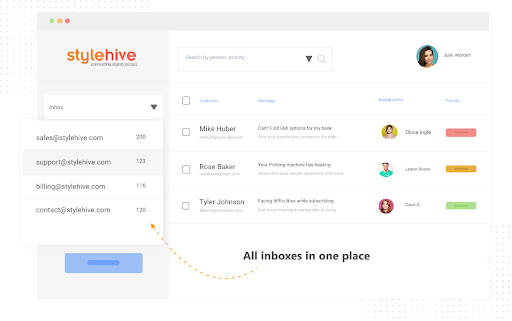
A help desk ticketing system helps team members access past conversations to personalize every single interaction. In addition to this, you can interact with online shoppers via live chat or build powerful chatbots to offer uninterrupted, 24×7 assistance.
You can even adopt an online survey tool to monitor CX metrics such as CSAT, NPS, CES, and more. The NPS or net promoter score is a powerful metric that can help you identify your at-risk customers along with your brand promoters.
Read More: 10 Benefits of Help Desk Software & Ticketing System
5. Create the Right Compensation Structure
Your CS team helps you retain customers and drive your business forward. If they are meeting their targets and keeping customers happy, it’s wise to compensate them for their hard work.
Here are some top ways to compensate your employees in addition to their salaries:
- Commissions: You can allocate a certain percentage of commission to CS employees. They can get a commission for upsells and account renewals. This will further encourage them to put their best foot forward and boost your company’s revenue.
- Employee Stock Options: ESOPs are another great option to retain your best and the most-experienced talent. You can offer ESOPs to the customer success professionals who have been loyal to your company for 3-5 years.
- Work Flexibility: Right from the onset of the 2019 pandemic, more and more companies have been offering flexibility in the form of work-from-home options, flexible timings, and so on. If your CS team members can deal with customers over the phone or email, you can offer them the flexibility they need. In fact, according to a study by Buffer, 90% of employees have a positive outlook toward remote work options.
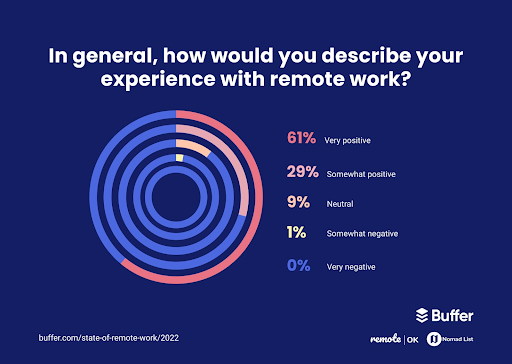
6. Give More Power to Your Team
Customer-success teams are directly client-facing. This means that they often encounter situations where they have to take permission from their immediate seniors or the supervisor.
Give more authority to your team to initiate product refunds, cancel or renew subscriptions, upsell, and perform other necessary actions.
Granting more power and authority to team members would mean that an appropriate solution can be provided at the earliest, and the customer does not have to wait for long.
For example, imagine a situation where a customer isn’t happy with a SaaS product and demands a complete refund per your policy. If the concerned customer success employee seeks permission from the manager, it could take a couple of days or weeks to get the desired approval. Such situations can hamper the customer experience and make them lose trust.
7. Capture Customer Feedback on Performance
How well do your team members meet customer expectations? Are customers happy with their interactions or the suggestions offered? There is only one way to find out – customer feedback surveys.
Your existing customers probably know more about your employees than you do. Any feedback they offer or changes they suggest have the capacity to improve individual and team performance.
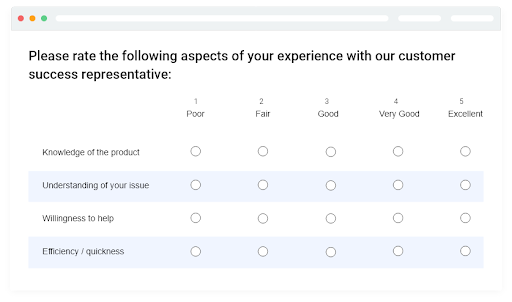
You can use the feedback to improve customer success procedures, inculcate new strategies, recognize top performers, or identify training gaps in your process.
While gathering feedback is a great first step, you need to follow up on the feedback to show your customers you’re always listening. On the other hand, you must acclaim and recognize staff members for what they are doing right. You can share examples of email or phone interactions that received positive feedback.
Read More: Customer Satisfaction Surveys: 100+ Questions & Examples
8. Teach Employees to Deal With Rejection
Customer success employees are consistently dealing with rejection. You pitch a client to use a higher-priced product, and they simply hang up the phone. You arrange a client meeting, and they never turn up.
Whether it is sales, customer service, or customer success, rejections are inevitable for client-facing teams. However, how you deal with such rejections can make all the difference.
Teach your employees to reframe rejections as opportunities or a call to action. They can always alter their perception and use the rejection to improve performance, work habits, and customer relationships.
Avoid taking rejections personally and move on to the next opportunity. There are multiple opportunities to sell more to existing customers and enhance their experience with your brand.
9. Focus on Your Purpose When Things Get Challenging
If you are a customer success manager (CSM) or agent, you need to revisit your purpose from time to time.
Just remember why you chose this profession and what makes you great at your job. For example, your professional purpose can be to help customers make the most of your products or to drive the business towards a sustainable and profitable future.
The same goes for your team. You must collectively define your team purpose and lay down your mission or vision statements. Have a mutual understanding of how you can support each other when challenges arise. For example, identify how you can support a CS representative who had a rough day with a client.
Since customer success is a relatively new field, not many departments know how it functions. Due to a lack of clarity, many interdepartmental conflicts can arise, leading to confusion and lowered productivity. Therefore, it’s best to focus on your purpose during times of turmoil.
10. Build a Customer-First Culture
Your business is alive today because of customers. And if you wish to sustain your business in today’s fierce competition, you must look to embrace a customer-first culture.
“Building a good customer experience does not happen by accident. It happens by design.” – Clare Muscutt
Here are some strategies you can adopt to build a customer-first culture:
- Focus on quality over quantity: Most customer-obsessed companies have one thing in common – they all prioritize quality over quantity. Instead of giving your complete attention to growing your customer base, you should be concerned about the relationships you foster with your existing customers.
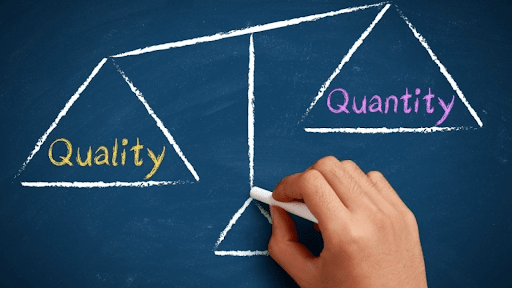
- Wear the customer’s hat: Ask your employees to wear the customer’s hat (figuratively). This way, you can better understand the challenges that customers might face with your products or services. Try to view things from the customer’s perspective to understand what frustrates them or what ignites their interest.
- Innovate & adapt: To become a truly customer-centric brand, you need to merge human capabilities with the right technology. Monitor the trending technology in your industry and embrace it to enhance the customer experience.
Read More: How to Create the Perfect Customer Service Philosophy
Customer Success Team Structure
The customer success team structure can depend on multiple factors – the size of your business, how customer-focused you are, etc. For example, if you are an MNC, you might create a proper hierarchy with the VP on top, followed by directors and managers. However, the same may not be feasible for a startup that is on a tight budget.
Here are the most common customer success roles and designations:
1. VP of Customer Success
The vice president of CS sits at the top of the customer success hierarchy. The appointed individual directly reports to the CEO of the company. The VP should be a highly experienced individual who can oversee strategy implementation and development.
Key responsibility areas:
- Look after the implementation of customer success strategies
- Take necessary actions to become a customer-centric brand
- Frame and protect the company’s customer success vision and mission
2. Director of Customer Success Operations
The director of customer success operations reports directly to the VP of customer success. The director is mainly responsible for the growth and development of the CS team. The VP and the director can together form strategies focusing on customer lifetime value and retention.
Key responsibility areas:
- Create consumer segments for improved targeting
- Identify customer success metrics that will be monitored
- Anticipate customer needs and expectations
3. Customer Success Manager
The customer success manager, like any manager, is mainly responsible for team handling. The management team assigns roles and responsibilities to individual team members and guides them to achieve their goals faster. The CSM can also interact with some top-tier clients to build better relationships.
Key responsibility areas:
- Hire, onboard, and train customer success employees
- Monitor individual as well as team performance
- Share reports with the leadership team and other stakeholders
4. Customer Success Coordinators
Customer success coordinators or employees are the ones who are always directly interacting with customers and helping them make the best use of what the company sells. The employees can be further divided into different functions or specialties. For example, CS analysts can produce data to analyze customer behavior. Similarly, renewal experts can share reminders with customers to increase renewal rates.
Key responsibility areas:
- Proactively interact with customers and answer any questions they may have
- Capture customer feedback and share suggestions with the management team
- Achieve weekly, monthly, or quarterly targets
Customer Success Team Vision
The best entrepreneurs realize that solid customer-focused programs aren’t built in a day. However, if there is one thing that inspires your CS team to keep moving in the right direction, it is a well-defined customer success vision.
A customer success vision is an aspirational statement that reflects how your team wishes to help customers attain success. The vision statements are curated to motivate team members and give them something to strive for.
Let’s understand this better with an example. Here is the customer success vision statement of UpKeep, a leading SaaS company.
“Our vision is to be a partner to our customers and act as one team. Our customers’ successes are our own.”
Remember that your team’s vision statement should be short, easy to understand, and free from business jargon. Feel free to share your customer success values with existing and potential customers to let them know how important they are to your brand.
Read More: What Are Help Desk Mission and Vision Statements?
How Is Customer Success Different From Support?
Many professionals use the terms customer success and customer support interchangeably. Both share overlapping functions and are critical to any company’s growth. But are they the same, or are there some major differences between the two?
Here are some points that will highlight the differences between the two terms:
1. Reactive vs. Proactive
As you might have guessed, customer service is more reactive in its approach. For example, a support agent offers a solution only when a customer shares a complaint or issue. On the other hand, customer success is more proactive in the sense that employees strive hard to minimize friction points and reduce challenges to help customers achieve their goals.
2. Transactional vs. Relationship-Oriented
Customer service interactions can be termed transactional as they begin when an issue is submitted and end when a relevant resolution is offered. On the other hand, customer success is an ongoing process that is more focused on relationship building. Customer success agents can leverage this relationship to share tips on using a product or practice upselling and cross-selling techniques.
3. Performance Metrics
The difference between customer service and customer success can also be highlighted with the help of metrics and KPIs. Customer service is focused on improving the speed and quality of support and considers metrics such as ticket resolution time, average ticket response time, etc., important. On the contrary, customer success teams focus on metrics such as customer retention rate, churn rate, customer lifetime value, and more.
Read More: 15 Help Desk Metrics to Improve Customer Support
Make Miracles Happen With the Best Customer Success Team
In the last couple of years, entrepreneurs have realized that the only way to make customers stay is to make them taste success with their products or services.
While you can acquire new customers with a great sales team, you need the best customer success team to ensure they stay loyal and engaged to your business. A powerful CS team can help you improve customer onboarding, encourage upsells, increase renewals, and strengthen customer relationships.
To build a high-performance team, you must start by hiring people who are passionate about helping customers achieve their desired outcomes. Be transparent about your expectations, offer them the right tools, such as ProProfs Help Desk software, and teach them how to deal with rejection without giving up.
FREE. All Features. FOREVER!
Try our Forever FREE account with all premium features!

 We'd love your feedback!
We'd love your feedback! Thanks for your feedback!
Thanks for your feedback!







